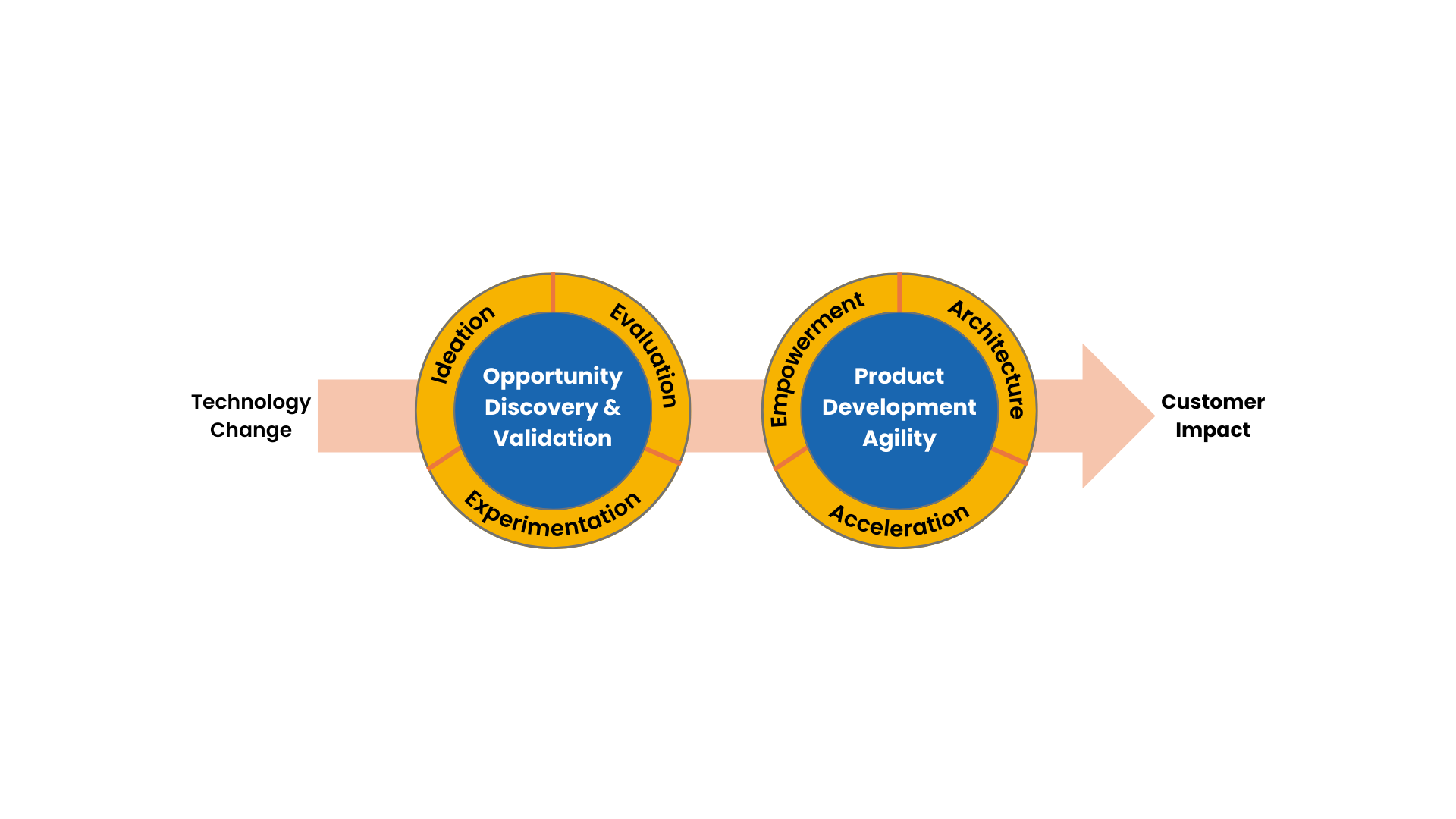
BrainRazr’s Catalyst Framework
Building Products That Win in a World of Rapid Technology Change
About the Catalyst Framework
Our framework helps organizations evaluate and adopt emerging and changing technologies to create real business value. It focuses on getting new solutions to market faster, reducing costs, and increasing revenue. BrainRazr's Catalyst Framework is built around two core capabilities: Opportunity Discovery & Validation and Product Development Agility. Each represents a group of competencies that we believe are critical to success in a fast-changing technology world: recognizing technology-enabled opportunities and enabling rapid adaptation to change.
Adopting a technology doesn’t guarantee value. In fact, jumping on every new trend without proper evaluation can hurt your business. The key is having the skills to assess technologies based on how they fit your products and market. Sometimes, the value isn’t in using the technology itself but in seizing opportunities created by its impact on the market.
Implementing these capabilities effectively requires investment in skills and experience around the core competencies that make up each.

Technology adoption isn’t about staying trendy—it’s about staying competitive.
BrainRazr's Catalyst Framework helps you spot real opportunities and act on them quickly, turning technology changes into competitive advantages.
Opportunity Discovery & Validation
This capability is about figuring out how technological changes can drive growth. It helps you spot, evaluate, and prioritize opportunities where new tech—or the shifts it causes—can deliver measurable results.
Organizations with a strong Opportunity Discovery & Validation capability consistently uncover valuable opportunities that others miss. They are proactive rather than reactive, identifying not just new technologies but also the business models, customer needs, and market shifts that those technologies enable. They invest wisely, focusing resources on solving the most critical customer and business problems with the highest potential for impact while avoiding costly detours into trends that don't align with their goals.
Without this capability
Companies often struggle with wasted investments, chasing every new trend without clear value. They face decision paralysis, slow response times, and missed market opportunities. Teams may feel overwhelmed by the volume of technological change, unsure of where to focus their efforts, often building features no one truly needs.
With this capability
Organizations make confident, informed decisions about where to invest. They recognize which opportunities align with their strategic goals, grounded in a deep understanding of customer needs. They test assumptions quickly, pivot when necessary, and focus on solving real problems that create measurable business value. This leads to faster time-to-market, better resource allocation, and a competitive edge in capturing emerging opportunities before the competition.
Core Competencies
Investing in the following core competencies is how organizations mature and maximize the effectiveness of Opportunity Discovery & Validation. These competencies build the foundation for making confident, data-driven decisions that consistently deliver value.
Ideation
Focus on identifying valuable customer and business problems to solve, not just generating ideas. This includes leveraging cross-functional collaboration and diverse perspectives to uncover hidden opportunities. The Innovator Mindset plays a crucial role here, encouraging bold thinking, challenging assumptions, and fostering a culture where novel ideas can thrive.
Evaluation
Analyze the costs, timelines, risks, and potential returns to decide which problems are worth solving. Use structured frameworks to prioritize initiatives based on strategic alignment and expected impact. The Investor Mindset is key in this phase, focusing on assessing potential returns, understanding risks, and making decisions grounded in data and long-term value.
Experimentation
Reduce risks with rapid, lightweight experiments such as quick prototypes, proof-of-concept tests, and real-world validation of technical and market assumptions. This allows for fast learning cycles, minimizing wasted effort on solutions that don't deliver value.
Product Development Agility
This capability focuses on how your organization builds and scales software products. It’s about developing the skills, platforms, tools, and processes needed to respond quickly to technology and market changes and keep delivering value.
Organizations with strong Product Development Agility can adapt quickly to changing conditions, turning validated opportunities into market-ready products faster than their competitors. They create resilient environments where empowered, cross-functional teams own outcomes, not just outputs. These teams continuously learn from customer feedback, adapt based on real-world data, and operate with a clear sense of purpose tied to business impact.
Without this capability…
Companies often face slow product development cycles, delayed time-to-market, and technical debt that hampers future growth. Teams become frustrated by inefficient workflows, lack of autonomy, and the inability to respond swiftly to new opportunities or threats. This leads to missed revenue potential, lower customer satisfaction, and difficulty staying competitive.
Core Competencies
Investing in the following core competencies is key to maturing and optimizing Product Development Agility. These competencies enable organizations to build adaptable, high-performing teams and systems that thrive in fast-changing environments.
Empowerment
Build strong, autonomous product teams that are accountable for outcomes, not just outputs. Empowered teams are more engaged, innovative, and capable of responding quickly to changing demands, continuously learning from customer feedback.
With this capability…
Organizations can rapidly adapt to new technologies, customer feedback, and market shifts. They build flexible architectures, streamline workflows, and empower teams to make decisions quickly. This results in faster delivery of high-quality products, continuous discovery alongside delivery, and the ability to capture market opportunities before competitors
Architecture
Create flexible, modular systems that support rapid experimentation and easy integration of new technologies. This reduces technical debt and ensures that products can evolve with minimal disruption.
Acceleration
Use automation, continuous integration/continuous delivery (CI/CD), and lean processes to speed up both discovery and delivery. This includes automated testing, efficient feedback loops, and fast, data-driven decision-making.

